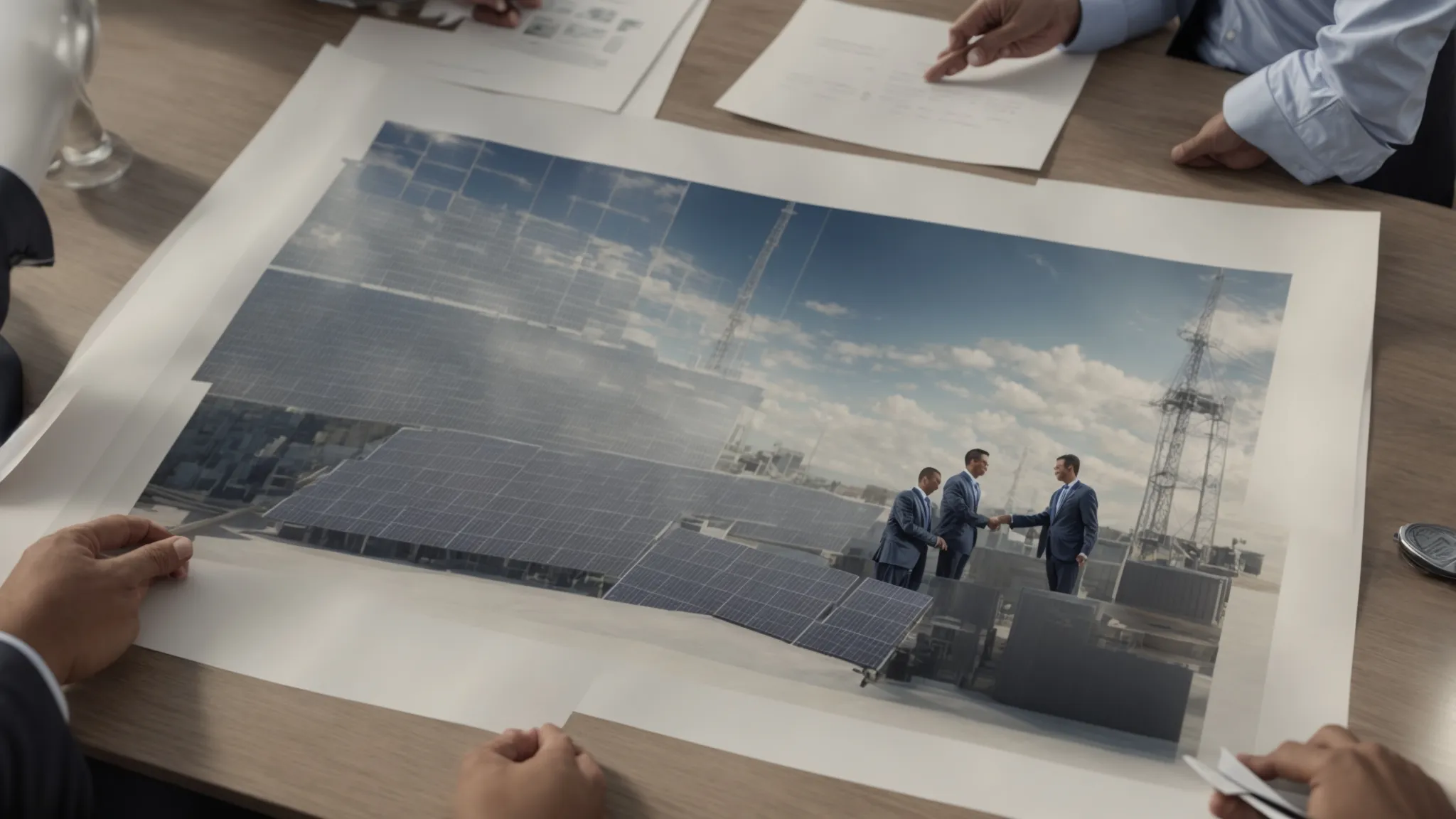Balancing Act: Global Environmental Concerns and Investor Rights
The intersection of global environmental concerns and investor rights is creating a complex landscape that stakeholders across the board are trying to navigate.
As the planet grapples with pressing issues like climate change, biodiversity loss, and pollution, there’s increasing pressure on corporations and governments to find a sustainable path that also respects the financial returns expected by investors.
This delicate balancing act requires innovative legal frameworks, corporate strategies, and investment models that prioritize environmental sustainability without sidelining economic growth.
At the heart of this challenge is the need for collaboration, creative thinking, and a deep commitment to both the planet and prosperity.
To explore how entities around the globe are addressing this issue, keep reading for insights on navigating the future of environmental investment.
The Role of Environmental Investing in Sustainable Growth
- Sustainable Investments Marry Economic Returns With Positive Environmental Outcomes
- The Integration of Environmental, Social, and Governance (ESG) Criteria Into Investment Decisions Is Pivotal for Sustainable Growth
- Public-Private Partnerships (PPPs) Play a Crucial Role in Advancing Green Projects and Environmental Conservation
- Legislative Efforts Globally Are Increasingly Focusing on Ensuring Investments Do Not Harm the Natural Environment
- Technological Innovations and the Rise of ESG Criteria Are Reshaping the Landscape of Sustainable Investment Opportunities
Understanding the Balance Between Global Environmental Protection and Investor Interests

The intricate dance between safeguarding our planet and nurturing economic expansion presents a dual challenge that societies across the globe grapple with.
At its core, the quest for harmony hinges on well-established principles that strive to marry environmental concerns with investment imperatives.
This delicate equilibrium seeks not only to mitigate the negative impacts of industrial growth on natural ecosystems but also to unlock the potential of sustainable investments.
Such investments aim to channel financial resources into projects that promise both economic returns and positive environmental outcomes.
Herein lies the crux of fostering a future where environmental protection and investor interests coalesce, guided by strategies that prioritize the planet’s health without stifling prosperity.
The Dual Challenge of Environmental Sustainability and Economic Growth
The juxtaposition of environmental sustainability and economic growth presents a nuanced arena where the future of our planet and the ambitions of investors intersect. With the stakes high, the creation of policies that facilitate this coexistence becomes paramount, simultaneously safeguarding our natural habitats and promoting avenues for robust economic development.
Achieving this synergy involves a meticulous evaluation of current practices, steering them towards sustainability without undermining the potential for financial gains. This entails an ongoing dialogue among scientists, policymakers, and investors, geared towards innovative solutions that respect the finite resources of our planet while tapping into the vast opportunities of green investments.
Key Principles Guiding the Balance Between Environment and Investment
The foundation of reconciling environmental conservation with investor interest lies in the principle of sustainable development. This approach encourages capital flow into ventures that yield financial returns without compromising the health and resilience of our natural environment. It underscores the importance of investments that support renewable energy, sustainable agriculture, and green technology innovation as pivotal to this balance. The principle of sustainable development aims to address environmental issues while supporting economic growth and social progress.
An essential principle guiding this equilibrium is the integration of environmental, social, and governance (ESG) criteria into investment decision-making. By considering the broader impact of investments on ecosystems, communities, and governance structures, investors and corporations can foster a more sustainable and profitable sustainable development goals. This shift requires a transformation in perception, recognizing that long-term environmental health directly influences economic stability and growth.
The Role of Sustainable Investment in Promoting Environmental Protection
Sustainable investment acts as a bridge linking the urgent need for environmental protection with the pursuit of financial prosperity. By funneling capital into projects that enhance the health of the planet—such as those reducing carbon emissions and preserving biodiversity—investors play a pivotal role in advancing the global agenda for sustainable development. This emphasis on eco-friendly projects not only safeguards our environmental heritage but also unveils new avenues for economic growth, affirming the viability of green investments.
Moreover, the advent of sustainable investment strategies propels corporations towards incorporating eco-conscious practices into their operations. This shift is crucial for reducing the ecological footprint of businesses, from minimizing waste production to adopting renewable energy sources. Investors, by prioritizing investments guided by strong Environmental, Social, and Governance (ESG) principles, induce a market transformation that aligns corporate behavior with environmental sustainability goals, ensuring a healthier planet for future generations. The focus on sustainable development goals is paramount in this transition.
How Governments Are Legislating for Environmental Protection and Investor Rights

As governments around the globe tackle the complex task of legislating in a way that upholds both environmental integrity and investor rights, a multifaceted approach has emerged.
Central to this initiative is the development and refinement of global environmental regulations that impact investors, a critical tool for navigating the delicate interplay between economic growth and ecological preservation regarding environmental issues.
Through an exploration of varied case studies, success stories highlight how some regions have managed to find an equilibrium, setting a precedent for future legislative efforts.
This subsection delves into these narratives, offering insights into how legislation can evolve to further support the concurrent goals of environmental protection and the safeguarding of investor interests in sustainable development goals.
As we look ahead, understanding these dynamics and anticipating future trends in legislation will be key to fostering a sustainable and prosperous global landscape.
Overview of Global Environmental Regulations Impacting Investors
Globally, regulations aimed at marrying environmental protection with investor interests are increasingly gaining traction. These legislative efforts are designed to ensure that financial investments do not come at the expense of the natural environment, curbing activities that significantly contribute to environmental degradation such as high greenhouse gas emissions or deforestation.
Among these measures, mandatory disclosure of environmental impact by corporations stands out as a critical step toward transparency: it directly informs investors about the environmental footprint of their investments, enabling more informed decisions that align with sustainable development goals and environmental issues:
| Regulation | Description | Impact on Investors |
|---|---|---|
| EU Sustainable Finance Disclosure Regulation (SFDR) | Mandates EU financial market participants to disclose sustainability risks and impacts of investment decisions. | Increases transparency, allowing investors to assess environmental risk and align investments with ESG criteria. |
| US SEC Climate Risk Disclosure | Proposed rules requiring publicly traded companies to disclose climate-related risks and greenhouse gas emissions. | Gives investors insights into potential climate risks associated with their portfolio, guiding more sustainable investment choices. |
Case Studies: Success Stories in Balancing Environmental and Investor Needs
A shining example of striking the right balance comes from Costa Rica’s approach to conservation and investment. The country has implemented payment for ecosystem services (PES) programs that compensate landowners for maintaining forests, which play a crucial role in carbon sequestration and biodiversity preservation. This strategic move attracts investors interested in sustainable practices while simultaneously fostering environmental conservation.
| Country | Program | Benefits to Environment | Benefits to Investors |
|---|---|---|---|
| Costa Rica | Payment for Ecosystem Services (PES) | Promotes biodiversity and aids in carbon sequestration | Encourages investments in sustainable practices |
In another instance, Denmark has emerged as a leader in wind energy, leveraging its policies to encourage investments in sustainable development goals. The Danish government’s support for wind power technology has not only reduced the country’s carbon footprint but has also served as a lucrative avenue for investors, propelling Denmark to the forefront of green energy innovation.
Future Legislative Trends in Environmental Protection and Investment Rights
Anticipating the trajectory of legislative efforts globally, a prominent trend emerges: the increasing integration of digital platforms and advanced analytics to monitor and enforce environmental protection measures without impeding on investor rights. This melds technology with regulation, streamlining compliance and facilitating more transparent and efficacious investment scrutiny.
- Adoption of sophisticated monitoring technologies to ensure ESG commitment.
- Development of global databases for tracking environmental impacts of investments.
- Implementation of dynamic policy frameworks adaptable to emerging environmental and investment challenges.
Simultaneously, there’s a palpable shift towards collaborative international legislation, aiming to establish uniform global standards for environmental protection that respects investor interests. This concerted effort underscores a collective acknowledgment of the intertwined fate of our environmental sustainability and economic prosperity, propelling nations towards unified action under the aegis of bodies like the United Nations Environment Programme.
The Rise of Green Investing: Opportunities and Challenges

The intersection of environmental responsibility and financial growth heralds a transformative era with the rise of green investing.
This strategy, rooted in the commitment to nourish the planet while yielding economic benefits, necessitates a deep dive into its framework, assessing its potential to redefine the investment landscape.
Defining green investing and its critical role in climate change mitigation introduces investors to a world where their financial decisions wield power in combating climate change and promoting sustainability.
Simultaneously, understanding the risks and returns associated with green investments exposes the intricate dynamics between profit and ecological impact.
Furthermore, innovations in green finance, including bonds, funds, and indices, present novel pathways for channeling capital towards sustainable development goals, shaping the future of both the global economy and the natural world.
This exploration not only underscores the viability of green investments but also highlights the evolving challenges and opportunities within this burgeoning field.
Defining Green Investing and Its Importance for the Environment
Green investing represents a financial strategy deeply integrated with the principle of environmental stewardship, targeted at directing capital towards ventures that offer both ecological benefits and economic gain. It emphasizes the allocation of resources to projects and businesses that contribute to a sustainable future, ranging from renewable energy generation to conservation efforts that bolster biodiversity and reduce pollution.
This approach not only mitigates the adverse effects of climate change by curbing greenhouse gas emissions and preserving natural habitats but also introduces a prolific avenue for investors to achieve returns on their capital through environmentally responsible avenues. Green investing embodies the conviction that financial success and environmental health are not mutually exclusive but are interdependent, setting a foundation for a resilient and thriving global economy with sustainable development goals.
Analyzing the Risks and Returns of Green Investments
Green investments bear their unique set of risks and returns, distinguished notably by the volatile nature of emerging green technologies and shifting regulatory landscapes. Investors venturing into sustainable projects must navigate these fluctuations, associated with rapid technological advancements and policy changes that could impact long-term viability and profitability.
However, the returns from green investments offer a compelling narrative for financial growth, underscored by the increasing global demand for sustainable solutions and the positive environmental impact these investments garner. The convergence of ethical responsibility and financial incentive establishes a persuasive case for green investing, promising not only a healthier planet but also compelling economic benefits for forward-thinking investors.
Innovations in Green Finance: Bonds, Funds, and Indices
Innovations in green finance, particularly in the forms of bonds, funds, and indices, are reshaping the landscape for investors aiming to contribute positively to the environment. These financial instruments enable capital to flow into sustainable projects like never before, expanding green investment opportunities beyond traditional markets. Green bonds, for instance, raise funds for new and existing projects with environmental benefits, such as renewable energy installations and sustainable agriculture practices.
| Instrument | Description | Impact |
|---|---|---|
| Green Bonds | Funds raised for environmental projects. | Directs large-scale investments into sustainability projects. |
| Sustainable Funds | Pooled investments in ESG-compliant companies. | Encourages corporate ESG practices and innovation in sustainability. |
| ESG Indices | Benchmarks tracking the performance of securities meeting ESG criteria. | Offers investors a transparent gauge of ESG investment performance. |
Moreover, sustainable funds and ESG indices provide frameworks for investors to support companies that adhere to environmental, social, and governance criteria, further aligning investment portfolios with sustainable development goals. This alignment not only fosters a greener economy but also enables investors to manage risk and pursue returns in a manner that is consistent with a commitment to environmental stewardship and social good.
Corporate Strategies for Aligning With Environmental Goals Without Compromising Returns

In the midst of an evolving global landscape, where environmental preservation demands urgent attention, corporations face the imperative of recalibrating their operations to foster a harmonious relationship with the planet.
This mandate has propelled an array of forward-thinking companies to the forefront of sustainability and profitability, showcasing the feasibility of integrating environmental goals with robust financial performance.
Through innovating business models that inherently prioritize ecological concerns and adopting corporate governance practices that enhance investment strategies with an environmental lens, these trailblazers exemplify the potential for business practices to contribute significantly to the global sustainability agenda.
Delving into the examples of such companies, the strategies they employ, and the influence of corporate governance provides insightful perspectives on the roadmap to achieving environmental and investment objectives in tandem.
Examples of Companies Leading in Sustainability and Profitability
Tesla, Inc., has emerged as a paragon among enterprises at the nexus of sustainability and profitability, aggressively driving the transition to electric vehicles to mitigate the environmental impact of the automotive sector. This innovative approach not only fuels advancements in clean energy but significantly elevates Tesla’s market position, exemplifying the potential for profitable ventures within sustainable industries.
Patagonia sets an exemplary standard for integrating environmental stewardship directly into its business model, committing to the use of recycled materials and dedicating a portion of sales to conservation efforts. Through these practices, Patagonia not only leads in environmental protection but secures a loyal customer base, proving that ethical commitments and profitability can indeed coexist within the competitive apparel industry.
Strategies for Integrating Environmental Concerns Into Business Models
One pivotal strategy companies deploy for embedding environmental concerns into their business models revolves around the adoption of green supply chain management. This approach not only emphasizes the production of goods and services that have minimal environmental impact and carbon footprint but also ensures sustainability is a core aspect of sourcing, manufacturing, and climate change mitigation. It serves the dual purpose of meeting consumer demand for eco-friendly products while promoting conservation of resources and reducing pollution.
Another strategic framework that corporations are increasingly embracing involves setting transparent environmental targets and reporting on progress. Committing publicly to specific, measurable environmental goals, such as reducing greenhouse gas emissions or achieving zero waste to landfill, holds businesses accountable and fosters trust among consumers and investors alike. This transparency in environmental performance encourages continuous improvement, aligning operational practices with broader sustainability objectives and investor expectations.
The Impact of Corporate Governance on Environmental Investment Strategies
The interplay between corporate governance and environmental investment strategies has emerged as a critical lever for steering businesses towards sustainability. Effective governance frameworks influence investor confidence by embedding environmental considerations at the heart of strategic decision-making, which, in turn, shapes the investment landscape.
Through the lens of corporate governance, companies are increasingly held to account for their environmental impact, driving an integration of sustainable practices within investment strategies. This accountability, reinforced by stakeholders’ expectations, fosters a culture of transparency and ethical management, catalyzing investments that prioritize ecological integrity alongside financial return:
| Company | Environmental Governance Strategy | Effect on Investment Strategy |
|---|---|---|
| ACME Corp. | Implementation of a Sustainability Committee | Shifts investments towards renewables and sustainable technologies |
| Green Innovations Ltd. | Public reporting on carbon footprint reduction | Attracts socially responsible investors and improves market valuation |
The Role of Public-Private Partnerships in Achieving Environmental and Economic Goals

In the intricate balance between conserving the environment and securing economic advancement, Public-Private Partnerships (PPPs) emerge as a pivotal mechanism.
They bridge the gap by pooling resources and expertise from both sectors to launch and propel green projects forward.
These collaborations have proven instrumental in ushering in a swath of successful environmental conservation and infrastructure endeavors, shaping sustainable futures across various regions.
Yet, while the path illuminated by PPPs hints at vast potential, it is also strewn with complexities.
Navigating these, from drafting agreements to ensuring mutual benefits, poses a distinct set of challenges that stakeholders must overcome to actualize the environmental and economic gains these partnerships promise.
How Public-Private Partnerships Are Facilitating Green Projects
Public-Private Partnerships (PPPs) are steering the deployment of green projects by leveraging the strengths and resources of both the public and private sectors. These alliances are instrumental in initiating and accelerating projects that aim at enhancing renewable energy capacity, improving waste management systems, and protecting vulnerable ecosystems, thereby contributing significantly to the global pursuit of sustainability and climate change mitigation.
Through the fusion of public oversight and private sector efficiency, PPPs offer a dynamic framework for addressing complex environmental challenges. This collaborative approach ensures that projects not only receive adequate funding but also benefit from innovative solutions and managerial expertise, substantially increasing the likelihood of successful implementation and sustainable outcomes.
Success Stories of PPPs in Environmental Conservation and Infrastructure
A vivid illustration of Public-Private Partnerships (PPPs) catalyzing progress in environmental conservation is the collaboration for the Thames Tideway Tunnel in the UK. This monumental project, facilitated through both public investment and private expertise, aims to tackle the pressing issue of sewage overflow into the Thames River, enhancing both water quality and urban resilience against climate change impacts.
| Project | Partnership Model | Environmental Goal |
|---|---|---|
| Thames Tideway Tunnel, UK | Collaboration between UK government and private sector consortia | Improving water quality and urban resilience |
In another success story from North America, the partnership between the city of Phoenix and a private company transformed the city’s waste management system: This venture introduced a state-of-the-art recycling facility, significantly reducing landfill usage and fostering a circular economy that repurposes waste into valuable resources, illustrating how PPPs can marry environmental ambition with economic practicality. Natural resource s are utilized efficiently in this partnership to drive sustainability initiatives forward.
Overcoming Challenges in PPP Agreements for Environmental Projects
Securing the success of Public-Private Partnerships (PPPs) for environmental projects necessitates navigating a landscape marked by intertwining legal, financial, and operational challenges. Ensuring both parties’ interests – environmental sustainability and financial viability – align requires transparent communication and flexible yet firm contractual agreements. It is through such meticulous preparation and shared commitment to project goals that PPPs can surmount potential obstacles, transforming ambitious environmental projects into tangible realities.
Addressing the complexity inherent in PPP agreements demands an astute focus on risk management strategies, something that becomes particularly pivotal when dealing with environmental projects. By laying out clear mechanisms for risk allocation and mitigation, stakeholders can preemptively address concerns that might otherwise jeopardize the collaboration. This proactive approach not only fortifies the partnership but also solidifies the foundation upon which environmental and economic objectives can be jointly achieved.
Navigating the Future: Trends Shaping Environmental Investment

The landscape of environmental investment is rapidly evolving, pushed forward by technological innovations, the ascending influence of ESG criteria in financial decisions, and the dynamic shifts in global environmental policies.
These factors collectively serve as the cornerstone for the imminent future of investments, intertwining the goals of environmental preservation and economic resilience.
Technological advancements are paving the way for new sustainable investment opportunities, while the integration of ESG criteria into investment portfolios is reshaping investor priorities and strategies concerning climate change mitigation and heat wave.
Concurrently, the future trajectory of global environmental policy promises to exert a significant influence on investment landscapes, dictating the direction of economic flows and the viability of long-term environmental politics ventures.
This confluence of trends stands at the precipice of redefining the very essence of how investments are evaluated, executed, and valued in a world that no longer views economic growth and environmental sustainability as mutually exclusive endpoints.
Technological Innovations Driving Sustainable Investment Opportunities
Technological advancements are opening up a new frontier for sustainable investment opportunities, enabling an intersection where innovation meets environmental stewardship. Breakthroughs in clean energy, such as solar photovoltaic systems and wind turbines, have drastically reduced the cost of renewable energy, making it an increasingly attractive option for investors. This shift not only promises high returns but also positions technology as a critical ally in the fight against climate change.
Moreover, the advent of smart technologies and the Internet of Things (IoT) is enhancing the efficiency of resource use in industries ranging from agriculture to manufacturing. By optimizing operations and minimizing waste, these technologies are creating investment opportunities that adhere to environmental, social, and governance (ESG) criteria. Consequently, investors are now able to support companies that are not only profitable but also contribute to a sustainable future.
The Growing Importance of ESG (Environmental, Social, and Governance) Criteria in Investment Decisions
The ascendance of ESG criteria in investment decisions marks a pivotal shift in how capital markets appraise risk and opportunity, underscoring a broader recognition of the long-term benefits derived from sustainable business practices. This change showcases a growing consensus among investors that environmental stewardship, social responsibility, and robust governance practices can significantly contribute to financial performance and risk mitigation.
Embracing ESG principles has become a strategic imperative for investors seeking to align their portfolios with global sustainability targets and societal expectations. This paradigm shift not only reflects an evolution in investor values but also anticipates regulatory trends favoring transparency and sustainability in corporate conduct, reinforcing the critical role of ESG criteria in shaping future investment landscapes.
Predicting the Future of Global Environmental Policy and Its Impact on Investors
The horizon of global environmental policy is expected to be increasingly characterized by stringent regulations aimed at combating climate change, with a significant emphasis on reducing greenhouse gas emissions and enhancing sustainable practices across industries. This evolving regulatory landscape will necessitate investors to adapt their portfolios, gravitating towards enterprises that are not only compliant with these new norms but also pioneers in green innovation.
As international agreements and national policies intensify focus on sustainability, the investment world will witness a profound transformation where ESG criteria emerge as primary factors in investment decisions. This shift propels a growing demand for transparency, compelling companies to disclose their environmental impact comprehensively, thus influencing investor strategies to favor long-term environmental sustainability alongside financial returns.
Conclusion
The balancing act between global environmental concerns and investor rights underscores the critical need to foster a stable, sustainable future that honors both the planet’s health and economic prosperity.
Emphasizing sustainable development, the integration of Environmental, Social, and Governance (ESG) criteria into investment decisions emerges as a fundamental strategy to align financial gains with environmental preservation and biodiversity.
Sustainable investments serve as a powerful conduit for directing capital towards projects that contribute positively to the environment, revealing the potential for economic growth driven by green initiatives.
Legislation plays a pivotal role in crafting a conducive environment for this balance, with successful case studies demonstrating how innovative policies enable the coexistence of robust environmental conservation and investor interests.
Furthermore, corporate strategies that prioritize environmental goals without compromising profitability exemplify the business sector’s capability to contribute to sustainability.
The emergence of Public-Private Partnerships (PPPs) showcases effective collaboration in achieving combined environmental and economic objectives, addressing complex challenges in green project execution.
Lastly, the evolving landscape of environmental investment, driven by technological innovations, the rising prominence of ESG criteria, and dynamic global environmental policies, highlights the imperative for investment practices that robustly support the intertwined goals of protecting the environment and securing investor returns.
This comprehensive approach not only paves the way for a sustainable economy but also reinforces the intertwined destiny of environmental integrity and financial health, ultimately guiding the global community towards a resilient and thriving future.


